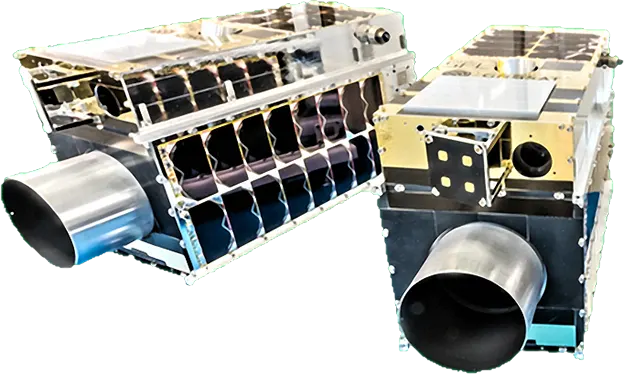GHGSat – C12 and C13
For global monitoring of greenhouse gases

SFL Missions Inc. developed two additional greenhouse gas monitoring microsatellites – GHGSat-C12 and C13 – for GHGSat of Montreal. The new satellites are built on the low-cost, high-performance 15-kg NEMO bus, the same used to build the first nine GHGSat spacecraft which continue to operate in excellent health. The precise attitude control and target tracking capability of the NEMO bus – rare among satellite platforms of that size – play a key role in the accurate pointing of the sensors. GHGSat-C12 and C13 launched on June 23, 2025.
The GHGSat-D (Claire) demonstration satellite launched in 2016. GHGSat-C1 and C2 launched on 2 September 2020 and 24 January 2021, respectively. On 25 May 2022, GHGSat-C3, C4, and C5 satellites were launched to join the three others already in orbit, and the GHGSat-C6, C7, and C8 satellites successfully launched on 15 April 2023. The commercial GHGSat-C1 through C8 spacecraft are currently in orbit.
Using attitude control technology for precise pointing of sensors aboard low-inertia platforms in orbit, the GHGSat constellation detects and measures greenhouse gas emissions from sources on the Earth’s surface.
GHGSat is the world leader in detecting and measuring facility-level greenhouse gas emissions from industrial sources on the Earth’s surface from space. Decision-makers across government and industries including oil and gas, power generation, mining, waste management, and agriculture rely on GHGSat emissions data to drive emissions reduction and accelerate the decarbonization of the planet.
In 2023 alone, the satellite constellation made more than three million measurements across 85 countries, enabling the mitigation of more than six million metric tonnes of CO2e of methane emissions, equivalent to removing more than 1.4 million cars from the road for a year.
The two new satellites are identical in design and technical capabilities to GHGSat-C6, C7, C8 that were launched in 2023.
GHGSat Background
GHGSat’s mission is to become the global reference for remote sensing of greenhouse gas (GHG) and air quality gas (AQG) emissions from industrial sites, using satellite technology.
GHGSat’s novel technology enables GHG and AQG measurement with better accuracy at a fraction of the cost of comparable alternatives.
In each industry, GHGSat measures emissions from target sites, anywhere in the world. Sites can include industrial facilities with fixed, concentrated sources of emissions (e.g., stacks), area sources with emission hotspots (e.g., landfill methane, pipeline leaks), fugitive sources over wide areas (e.g., tailings ponds, mine faces), and mobile emitters (e.g., ships).
Each GHGSat satellite provides periodic, high-precision measurements of emissions from thousands of such sites. Targeting of measured emissions is confirmed with visual imagery from the same satellite. GHGSat instruments are calibrated regularly, and measured data is verified and validated against known sources.
GHGSat provides measurements of emissions at each site without using any on-site equipment. However, GHGSat can augment its measured data with any publicly available data (e.g., local meteorological towers) or private customer data.
